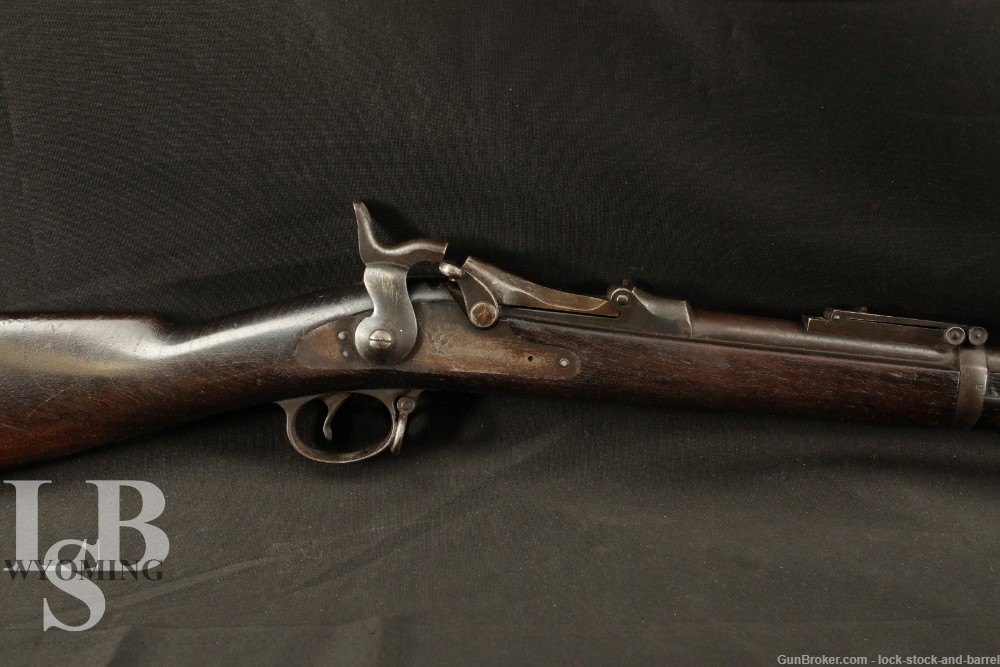
Springfield 1884 Trapdoor Service Rifle .45-70 Bayonet Ramrod 1891 Antique
SOLD FOR: $1,026.00
WOA#: WY240526MC014
Make: Springfield
Model: 1884 Trapdoor Service Rifle w/ Bayonet Ramrod
Serial Number: 97111
Year of Manufacture: 1891 (acceptance Cartouche)
Caliber: .45-70 Government
Action Type: Single Shot Trapdoor
Markings: The top of the breechblock is marked “U. S. / MODEL / 1884”. The right lock-plate is marked with the Springfield Eagle and “U.S. / SPRINGFIELD”. The left side of the barrel is marked with a “V”, “P”, an Eagle head proof and a second “P”. The top of the buttplate in front of the mounting screw is marked “U S”. The right sides of the barrel bands are marked “A”. The right side of the buttstock is “12 / 279”. Behind the lower rear tang you can see a circle “P” proof.
Barrel Length: 32 1/2”
Sights / Optics: The front sight is a blade pinned to a rectangular base set on the barrel. The rear sight is a Buffington ladder sight that was used on the M1884 rifles. There is a “U” notch sight fixed to the rear of the ladder for use as a battle sight when the ladder is folded down. The base of the sight is adjustable for windage. The right side of the ladder is marked from “2-14”, with a hash line every 100 yards. The top right corner of the ladder is marked “R”. The left side of the ladder is marked “15-20” with a hash line every 50 yards.There are four different sights for use when the ladder is raised: there is a small peep sight at the bottom of the slider for use as a battle sight, a “U” notch in the base of a triangle for use from 200-1400 yards, a peep near the top of the slider for use at 1400 yards, and a “U” notch at the very top of the slider for use from 1500-2000.
Stock Configuration & Condition: The stock is a one-piece walnut with a smooth straight grip. The buttstock has a steel carbine style buttplate with a storage compartment door. The forend is nearly as long as the barrel, with a blued steel nose cap. The forend is held with two steel barrel bands. There is a sling swivel at the front of the trigger guard and a sling swivel and stacking swivel on the bottom of the front barrel band. There are scattered compressions and dings through the finish. The LOP measures 13 1/8” from the front of the trigger to the back of the buttplate. The US marked plate exhibits typical wear for an antique rifle, finish loss, patina, and light surface rust. Overall, the stock is in about Very Good condition as Antique.
Type of Finish: Blue & Case Color
Finish Originality: Original
Bore Condition: The bore is semi bright, with minimal deterioration to the rifling. There is light surface erosion in the bore. No major deep pitting. This bore rates in 8/10 for a bore rating in this writer’s opinion.
Overall Condition: This rifle retains about 15% of its metal finish. The barrel and bands have turned to patina. The lock-plate and breechblock have some very faint case color remaining but have mostly turned to patina. There are some scattered scratches and dings on the barrel. The bottom metal assembly shows scattered scratching and surface oxidation. The hammer has some of its finish but shows oxidation. The screw heads are lightly tool marked with strong slots. The markings are mainly clear and the barrel proofs are strong. Overall, this rifle is in about Very Good condition as Antique.
Mechanics: The action functions correctly. The hammer has quarter and half-cock safety positions. We have not fired this rifle. As with all used firearms, a thorough cleaning may be necessary to meet your maintenance standards.
Box, Paperwork & Accessories: Ramrod bayonet included.
Our Assessment: The first thing that catches anyones eye about this rifle is the Ramrod Bayonet and the aged patina throughout.The U.S. breech loading Springfield “trapdoor” rifle was introduced in 1873 in .45-70 caliber. Basically it was the rifle the U.S. Army used to open the West and Springfield trapdoor carbines were used by Custer’s Cavalry at the massacre at The Little BigHorn.
In 1884 the integral Round Rod Bayonet was introduced, which could double as a cleaning rod,a development that met with very limited success. It was finally replaced in 1892 with the .30-40 caliber Krag bolt action magazine Rifle.
Model 1884 rifles saw service in the Spanish American War. The regular army was issued the new Krag rifles and the guard units received the trapdoor. There are a number of stereopticon pictures that show guard units armed with 1884 rifles.
The Model 1884 round rod bayonet rifle was Springfield’s third attempt at a rod bayonet system on a trapdoor rifle. They had used the triangular rod system on the Model 1880 and some Model 1882 rifles. The Model 1884 RRB rifle utilized a different, but no more reliable mechanism for retaining the rod. Because the small locking “fingers” are not clearly visible, the gun has been nicknamed “flat latch.”
We wish this rifle could talk. It would make a great piece for any Historical Military Collector with potential for more research and future discussions.So bid high and bid firm. I highly encourage you to take a look at the condition in our high quality photos. Good luck on your bid. -K.F.

